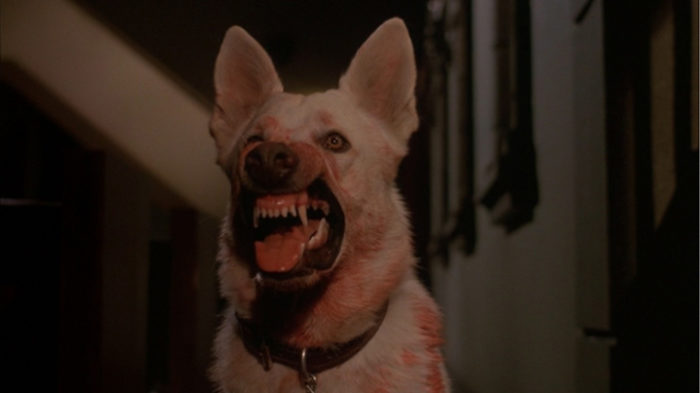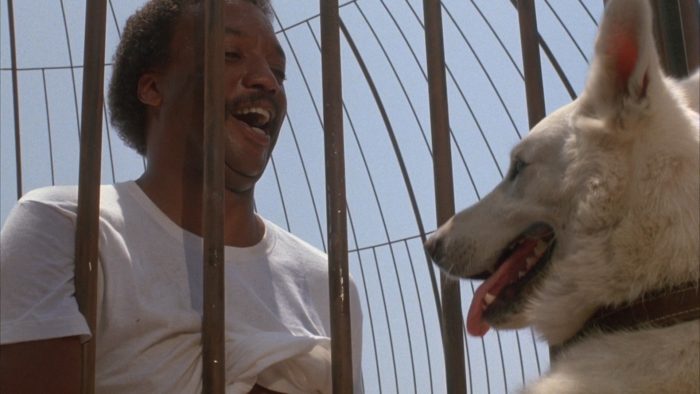
One of the more potent topics in all of movies, and one in which I’m guessing the argument is pretty slanted in one direction is “is it ok to kill a dog in a movie?” The obvious answer is almost always “no”, because why on Earth would someone want to watch a dog die onscreen? They’re one of the most unabashedly affectionate creatures on Earth, even if some of them seem to misplace their ragged-eared enthusiasm in the form of ripped up newspapers and traumatized mailmen half the time. White Dog, however, aims to point the argument in the other direction, even as hard a task as that may be. Because, yes, dogs are great. But they also tend to reflect their masters, so what do you do when a dog becomes the walking embodiment of man’s worst instincts?
Of course, we never assume that any given dog is an asshole, and especially one that’s in pain. At the start of this film, it’s this thinking that compels a young actress named Julie (Kristy McNichol) to adopt a White German Shephard one night, after accidentally hitting him with her car. The pooch proves to be a good guard dog for a young single woman living alone, as he viciously attacks a burglar who breaks into her house one night. However, the dog’s penchant for blood becomes increasingly unsettling after he goes astray one night (to attack a black truck driver), and comes home covered in blood. Which is then followed a few days later, when Julie is on a film shoot, and one of her fellow actresses (also an African-American) is attacked so badly by the dog that she ends up in the hospital.
Since something is clearly up with this dog, Julie takes her angry pup to a dog trainer named Carruthers (Burl Ives), who immediately tells her the dog should not be kept alive because he’s straight-up racist. That’s right, this is a movie in which Sam the Snowman waxes poetic about the concept of “white dogs” – dogs that are bred by their trainers to attack and kill any black person they see – and that Julie’s adopted dog is one of them. However, we then see a headstrong African-American man named Keys (Paul Winfield), who also works at Carruthers’ ranch, who takes it upon himself to wipe the racist instincts out of this dog.
Now, after reading that synopsis, I bet you’re probably thinking “wow, that sounds really heavy, if a little absurd”, and you wouldn’t be the first one. In fact, upon its completion in 1982, apart from a few mixed preview screenings, White Dog was never released by its studio, Paramount. And only became available on video in 2008, when Criterion finally released it. Supposedly, the studio was nervous about the film, due to the clearly controversial subject matter, while the NAACP thought it would incite violence against African-Americans, despite the fact that the film is staunchly anti-racist. Though it didn’t help the film’s case that it was made by a mostly white cast and crew, while it was based on the novel of a white writer, Romain Gray.
And to be honest, I’m surprised a socially-minded film like this would ever get made in the first place by a major studio in the blockbuster era of the 1980s, though it sounds like a lot of that had to do with a looming writers strike. And because the film was far along enough in production, the studio gave the long-dormant Samuel Fuller, against all odds, the chance to direct the kind of thoughtful B-movie that he excelled at two decades earlier. And in that regard, I was quite pleased (but also disheartened) to see that the film’s ideas on racism – as this thing that can be tempered and contained, but never truly removed – held up quite well, unfortunately.
I say I was pleased, because it sounded like Sean had kind of a rough time making sense of Dressed To Kill‘s outdated handling of trans people on film. White Dog, on the other hand, benefitted from having a director at the helm who was a supporter of the Civil Rights movement, and was known to go out of his way to cast non-stereotyped black actors in his films. That said, I could see how someone would take issue with Fuller’s handling of race in this film. Since it’s far from subtle, due to its scenes of (a really great) Paul Winfield pontificating on the irrepressible nature of bigotry, combined with its slo-motion images of a vicious dog constantly charging towards the seemingly harmless sight of black skin, shining in the California sun.
As I discovered earlier this year, with our original Criterion month, Samuel Fuller’s films contain a style that I was surprised to find existed – trashy pulp, but with a surprising depth of humanity. White Dog I would say certainly falls into that vain, since despite its studio backing, clearly wasn’t made for a ton of money. Yet, the fact that it so powerfully explores this idea of all the hate and bigotry of white America packed into this single dog, makes it something not to be forgotten, even if that’s what it was intended to be by its distributors.
Also, the fact that it contains a scene in which Sam The Snowman talks about racist dogs AND and how much he hates R2-D2, makes it pretty awesome in my book.


